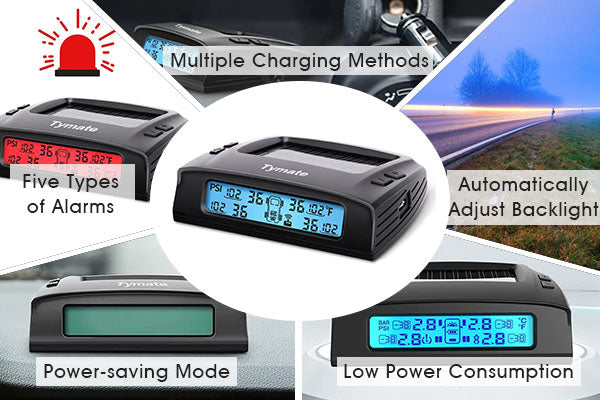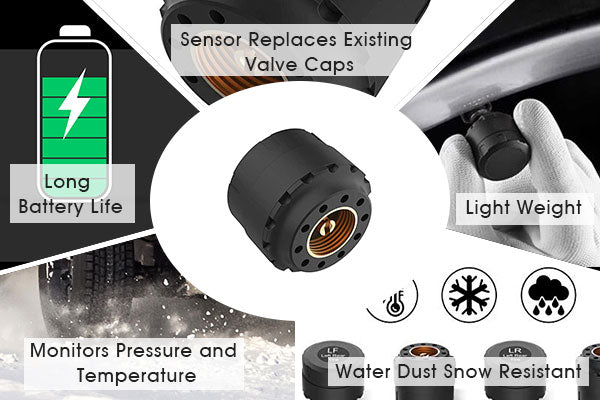
What is TPMS? How does it work? Can I install it? What is the difference between activating and programming? If these are some of your current questions, here are the answers.
TPMS is already mandatory in most states in the US. Gathering the proper information and how to manage diverse situations that could arise is vital.
This blog post will focus mainly on how to activate your TPMS. We will briefly explain how TPMS works and its purpose within your vehicle. Additionally, we will learn about the difference between activation, relearning, and programming.
TPMS Basics

TPMS stands for Tire Pressure Monitoring System, and it consists of small electric devices installed into each wheel and mainly control your tire pressure. We say this mainly since TYMATE TPMS also controls how external factors affect your tires and when driving is unsafe.
For your TPMS to work efficiently, you need to install and activate one sensor per wheel. You can place them even in your trailer if you have some TPMS installed in your car. As it can be installed in your trailer, it can also be placed in your motorhome, RV, and spare tire.
You will find two types of TPMS.
Indirect TPMS
Come already installed in your car. Since 2018 most car companies started to install this type of TPMS. The way it works is together with your ABS. The ABS tracks your wheel's speed, and if there is low pressure, that wheel will track slower. That will turn on a yellow alert on the driver's dashboard.
With this system, the driver will not know which tire is low on pressure.
Direct TPMS
Sensors need to be installed into each wheel, and you will encounter different types in the market. Some trucks can read up to 10 wheels and cars.
Direct TPMS provides more accurate and real-time readings from each tire installed by this electric device.
It can detect tire pressure by temperature changes. If the temperature is high, there might be low pressure. If the temperature is cold, the opposite can happen. The monitor will alert the driver when it is safe to drive, generally when the pressure is 25% lower than the recommended.
TYMATE has different types of TPMS according to the vehicle you need to install.
Cars
CL205. It is small and convenient for any car. The monitor is the ideal size and can be fitted anywhere. For more details, click here.
TYAMTE TPMS. The model number is TM527M. This monitor offers a larger screen. Ideal for pickup trucks or any 4WD vehicle that are larger. You can get more information here.
Large Vehicles
Rv and Trailers. Auto Solar Charge is ideal for larger vehicles or your boat trailer. It charges automatically with solar power. The screen is longer but easy to read. For more details, click here.
Benefits

There are many benefits if you have TPMS. We will not get into details but mention some of them.
Safety is the primary benefit. You will prevent many dangerous outcomes since it controls your wheels completely.
Money also has its effect. Since you are aware of the state of your tires, you will not misuse them; therefore, they will last longer.
Extended tire life. Yes, we mentioned it, but it is relevant to highlight that your tires will last longer than you expected. TPMS ensures you drive with ideal air pressure, making your tires work efficiently and wear evenly.
Adapts to different vehicles. Even though there are various models of TPMS, you can adjust different versions to the same car. The only limit you have is censoring the tires the monitor is set up with.
What Is Activation?

When you activate your TPMS, the device sends all the proper information to the monitor. The information TPMS gathers is tire pressure, sensor ID, battery status, and vehicle temperature.
What often occurs is that with your new TPMS, you try to scan it with your TPMS tool, and it shows "no data found." This means your TPMS is not activated since manufacturers now want your gadget's battery to run dead.
How To Activate Your TPMS Sensor?
It is easy when it comes to activating your TPMS sensor. Follow these steps, and it should work perfectly.
- Install your new TPMS in your wheel
- Inflate them to ideal air pressure
- Trigger them with your TPMS tool
These steps, in general, will work with any TPMS. However, in some cases, your TPMS tool cannot detect any activation.
- Follow steps 1&2 again
- Release air for at least 3 seconds while you trigger your sensor.
This last step will certainly "wake up" your sensor and read it immediately.
You can also watch this video following the steps mentioned above.
Troubleshooting While Activating Your TPMS

Not detecting your sensor.
You can check your manual guide if you are trying to find out what type of TPMS sensor you have. Your TPMS tool will only detect Direct ones if you do not find it. It only detects this type since they are installed in your wheel.
This can be why your TPMS tool cannot detect your TPMS since indirect are installed within the ABS.
Accurate reading
Make sure you hold your TPMS tool for an accurate reading properly. When your sensor is trying to read, it must be placed at the tire's side wall. If this is not done correctly, your sensor may not activate. The reason is that low radio frequency only activates the device. If the tool is placed incorrectly, then there might be some interference.
Update Your TPMS Tool
More often than not, your TPMS tool can need to be updated. As a result, you cannot detect nor activate your TPMS sensor.
Activate, Relearn, Programm, Are They The Same?

The real and short answer is no, they are not. When you activate a TPMS, it means it is new and unused. When we talk about relearning, we refer to the new information your monitoring system has to gather. For instance, you may need your TPMS to relearn a sensor if you change tires. Programming is trickier and requires specific tools and updated software.
The first two definitions can be done by yourself. For the last one, we recommend you consult with a TPMS technician.
In Summary
TPMS is revolutionizing the automotive market. It is a device worth investing in, even if your car already has one, but for the rest of your vehicles. You will encounter many positive outcomes, from a longer lifespan with your tires to better fuel consumption.
Yet, knowing how to install and activate them is important. Ensuring all your tires are properly inflated and you understand activating with programming will save you many headaches.
We hope this blog post clarifies and you can install and activate your new TPMS properly.
See you in the next blog post!


